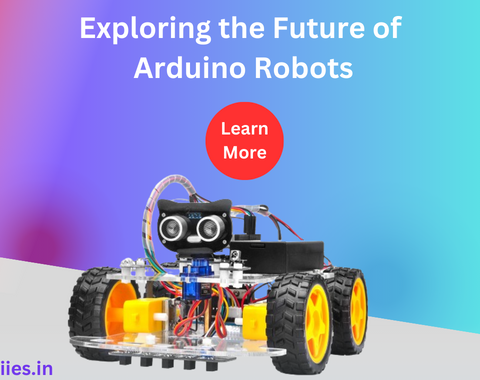
In the realm of electronics and programming, the Arduino robot stands as a testament to the fusion of technology and creativity. Arduino, an open source electronics platform, has empowered enthusiasts, hobbyists, and professionals to delve into the world of robotics with ease.
In this article, we’ll explore the exciting possibilities that Arduino robots bring to the table, from educational endeavors to innovative projects that push the boundaries of imagination.
At the heart of the Arduino robot lies the Arduino microcontroller, a versatile and user-friendly platform that has become synonymous with creativity in the world of electronics. Arduino boards are the perfect starting point for beginners due to their simplicity and ease of use, yet they offer advanced capabilities for seasoned developers. The Arduino ecosystem includes a wide array of boards, sensors, actuators, and shields that can be seamlessly integrated to create a diverse range of robotic applications.
The fundamental components of an Arduino robot include the Arduino board, motor controllers, motors, sensors, and a power supply. The simplicity of the Arduino platform makes it accessible for enthusiasts with varying levels of expertise. Many robotic kits specifically designed for Arduino provide a structured approach for beginners, offering step-by-step instructions and pre-configured components that simplify the assembly process.
One of the key strengths of Arduino lies in its programming environment. Arduino uses a simplified version of C++ to create code that controls the behavior of the robot. The Arduino Integrated Development Environment (IDE) provides a user-friendly interface for writing and uploading code to the Arduino board. This simplicity in programming allows beginners to quickly grasp the basics of robotics and gradually progress to more complex projects.
Arduino robots have become invaluable tools in education, serving as a bridge between theoretical concepts and hands-on experience. Educational institutions worldwide have embraced Arduino to introduce students to the principles of programming, electronics, and robotics. The interactive and engaging nature of building and programming robots enhances the learning experience, making it both enjoyable and effective. In the classroom, students can work on projects ranging from basic line-following robots to more sophisticated designs that incorporate artificial intelligence and machine learning. The modular nature of Arduino components allows for scalability, enabling educators to tailor projects to the skill level and interests of their students.
Beyond the realm of education, Arduino robots have found a niche in rapid prototyping for inventors, engineers, and makers. The ability to quickly assemble a robot using off-the-shelf components, coupled with the ease of programming, facilitates the rapid development of prototypes. This agility is particularly advantageous in industries where swift iteration and testing are paramount. Entrepreneurs and inventors can leverage Arduino robots to bring their ideas to life, test concepts, and gather valuable data for refining their designs. This democratization of prototyping has lowered the barriers to entry for innovators, paving the way for a more dynamic and diverse landscape of technological development.
Arduino robots are not confined to the realms of science and engineering; they have become powerful tools for creative expression and artistic exploration. Artists and designers incorporate Arduino technology into interactive installations, kinetic sculptures, and performances, blurring the lines between technology and art. The ability to control movement, lights, and sounds through Arduino programming allows for the creation of dynamic and responsive artworks. The versatility of Arduino opens up new possibilities for artists to experiment with robotics, creating immersive and interactive experiences that captivate audiences and challenge traditional perceptions of art.
Arduinos compatibility with the Internet of Things (IoT) has expanded the capabilities of Arduino robots into the realm of connected devices. By incorporating Wi-Fi or Bluetooth modules, Arduino robots can communicate with other devices and exchange data over the internet. This connectivity enables the development of smart robots that can be remotely controlled or interact with other IoT-enabled devices. In the context of home automation, Arduino robots can serve as intelligent assistants, capable of performing tasks such as monitoring environmental conditions, controlling appliances, or even providing security through surveillance capabilities. The fusion of robotics and IoT opens up a vast array of possibilities for creating intelligent and interconnected systems.
While Arduino robots have democratized robotics and provided a platform for innovation, challenges persist. As projects become more complex, users may encounter limitations in terms of processing power and memory on standard Arduino boards. However, advancements in hardware, such as the introduction of more powerful microcontrollers, are continually pushing the boundaries of what is achievable with Arduino. Furthermore, the integration of more advanced sensors and technologies, such as computer vision and machine learning, is an area of active development within the Arduino community. As these capabilities become more accessible, Arduino robots will likely evolve to tackle more sophisticated tasks, fostering a new era of intelligent and autonomous machines.
The Arduino robot embodies the spirit of exploration and innovation, providing a versatile platform that caters to a diverse audience, from students and hobbyists to professionals and artists. Its ease of use, coupled with a vast ecosystem of components and a supportive community, makes Arduino an ideal gateway into the world of robotics. As we look to the future, Arduino robots are poised to play a pivotal role in shaping the landscape of technology, education, and creative expression, proving that the fusion of electronics and robotics has the power to transform ideas into reality.
Indian Institute of Embedded Systems – IIES